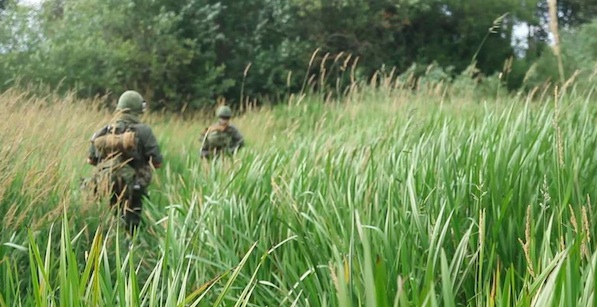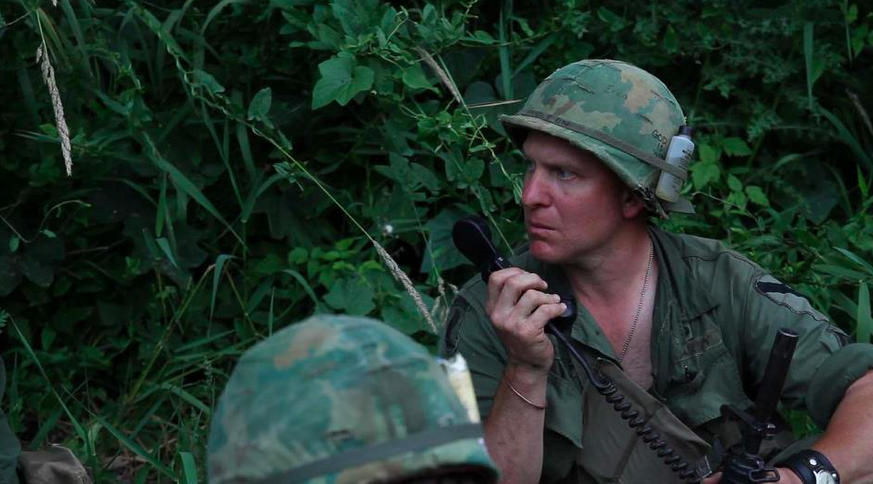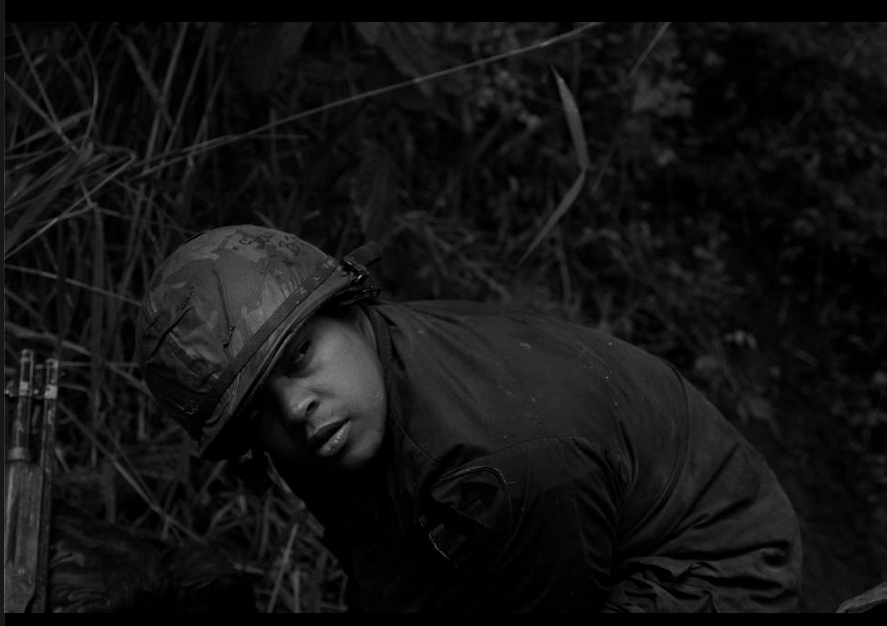
You’ll find yourself questioning your perceptions when you watch In Country. Immediately, what looks like a mockumentary about Vietnam is invaded by a 2014 pickup truck. Later, footage from an actual Vietnam doc says, “We’re looking at the sky from some cop-out angle.” Perhaps the material is self-investigatory or sometimes jaded, but documentarians Mike Attie and Meghan O’Hara know they’re representing a situation full of holes and wounded motives—whether that situation is happening in 2014 or fifty years ago.
Attie and O’Hara met in graduate school at Stanford, where Attie’s budding interest in filming re-enactment groups helped them start a plan. It’s a good subject for a modern documentary maker—the filmmakers and the subjects can be complicit in performance. According to Attie, it only took a bit of research to find the group in Oregon they filmed. Lead by Joel Kinney, an avid collector of Vietnam memorabilia, the group of veterans and civilians gather to reenact the motions of Vietnam’s first cavalry in the woods at the peak of summer. They call themselves The D 2/5 in honor of unit they represent. O’Hara adds, “When they write their name, they add (R) in parentheses next to it so they’re never mistaken for a real thing.”
Most of the D 2/5 (R) survived multiple tours in Afghanistan or Iraq and openly say they love being soldiers. So while no man admits to sadness or suffering from war (though one medic addresses his PTSD directly) each in the reenactment is working through something. Two members of The D 2/5 (R) served in Vietnam, and those men “are treated like kings.” Perhaps, Attie says in our interview, these men crave the reenactment because it’s a place their contributions can be respected. And, it’s implied, it’s a place their soldiering can resemble their expectations. I spoke with the filmmakers as In Country began its theatrical runs, which continue through the spring.

Sara Maria Vizcarrondo: The men of D 2/5 (R) appear to be playing war to re-discover authenticity; they’re faking to find real feeling. What differentiates what they’re doing and Live Action Role Playing? Or macho art therapy?
Mike Attie: I think, in a small way, it is different, but my sense is the vets are playing thought the scenarios they’ve already experienced but in a space where it’s safe. People are shooting guns but without real bullets or consequences. Also, the vets are in a place where their service is both respected and understood, and that might not be the case for their day-to-day lives—in or out of the army.
Meghan O’Hara: It’s also an investment in history. They’re trying to understand the soldiers that came before them. For the guys with military experience in Iraq or Afghanistan it’s a way of entering an experience close to theirs but perhaps more or less intense. It has the distance of history but things overlap with their own experience.
Vizcarrondo: We learn a lot about ‘the kind of war this war is’ from archival audio and the Vietnam War is described as ‘pure hell.’ So why do they chose this war to play out?
Attie: In a sense they can play themselves. That war was forty-to-fifty years ago but the soldiers look at pix of guys in Vietnam and there’s something about them that looks cool and the guys are connected to the music. While all those things are true, the big consistency was the men connected with the Vietnam era’s experience of coming home and not understanding what the war had been for—or about. Some had a desire to connect to family members; it can help people in our generation understand what their parents went through.
O’Hara: And for the two vets who participated in Vietnam, it’s an investment in their own history and experience, and a means of revisiting that past.

Vizcarrondo: You ask Sergeant Win, the only Vietnamese member of the group, why he’d want to relive the war, and then you install expressive archival footage of Vietnam and it kind of implies that we’re viewing his traumas. How did he feel about that choice? It could read as a sort of projected or false memory of a real experience.
O’Hara: That scene includes archival footage of Viet Cong and suspected Viet Cong soldiers found in a village, and that’s one of the many things we associate with the Vietnam war. Going into villages and seeking out Viet Cong was one of the stories that made it clear how difficult it was for Vietnam-era soldiers to identify their enemy. On the first day in the field, the re-enactors orchestrated that scene for the cameras. They brought in the Viet Cong re-enactors as if they’d been captured in battle. They told us, ‘you guys stand here and we’ll bring them down.’ That was one of the images they wanted to re-enact; we wanted to counter the archival footage of those events with the fantasies the re-enactors played out. We didn’t know how D 2/5 (R) were going to take it. In the end they yelled at them [The ‘Viet Cong’] a bit and ended the scene and that’s how we ended it in the film. Also we seldom get a view of the Vietnamese perspective on the experience. Win’s experience includes losing a country and becoming a refugee. We wanted to understand why he’d want to reenact this but he describes it a time when was fighting for his beliefs and his country. It was one of the more vital times of his life—a defining moment—so we tried to show that as much as we could. (citygoldmedia)
Vizcarrondo: When you began exploring the D 2/5 (R) what did you expect to hear about their group?
Attie: If you reenact the Civil War, you can go to the location and replay the event. For WWII, you can’t go to locations, but there’s still this honor to the battle. Vietnam…you don’t have locations and there’s a kind of lack of honor. When we found the reenactment groups, Meghan and I talked about doing this [documentary] after [we finished] school. We researched and there was almost one group per state that reenacts Vietnam and so we came to it with a really open mind. We knew before we began it’d be easy for someone to make a mockery of what they’re doing and we do have some humorous bits in the film, but we were interested in being respectful to the re-enactors and uncovering why they do it. We found Joel Kinney, the leader of the group, and the requirement for us was to be war correspondents: we had uniforms and boots—
Vizcarrondo: You were part of the re-enactment—costumed re-enactors—did the line get blurry?
O’Hara: No. If I asked a question about what happened last night I knew I wouldn’t get an answer that would go outside the bounds of the fantasy. If we were going to explore this we had to figure out what’s inside their heads. Of course the trick was ‘how do you represent this’ and it wasn’t helpful to look at them from afar. As much as these guys have an attraction to war, the greater culture is guilty of that as well. We all love our war movies and we wanted to put the audience in the uncomfortable position of going along with the reenactment and not going along with it from a remove. We certainly weren’t in the chain of command. We acted independently and we could shoot whatever we wanted to shoot—and it was a small and handy concession to make to wear the outfits.
Vizcarrondo: Do you feel you…shared the fantasy?
O’Hara: When you get out there you’re cut off from the rest of the world. All you have is this game. It’s immersive and kind of scary when you don’t know when someone could jump out at any time. The guns are real and they’re shooting blanks but those are still really loud. We were following D 2/5 (R) the way you follow a military unit. We had to react to things happening as they happened. It wasn’t possible to have insider knowledge they didn’t have—other than everyone knowing it would end at a certain time.

Vizcarrondo: Can I tell you, I thought a lot about mash-up culture when I watched this. I know that sounds random, but mash-up culture is about finding relics and eras that speak to you and inhabiting them with no obligation to commit. There’s no shame in trying on the sixties and taking it for a spin.
O’Hara: I can’t speak to that because I’m not familiar with it but something adjacent to that is how pop culture permeates the reenactment. The re-enactors are obsessed with pop culture reference—[and those references] are a way we see Vietnam hasn’t left our culture. Also, not as obvious, when they’re talking to the camera, often they’re paraphrasing PBS documentaries they’ve watched about the war. The speech Kinney makes at the end about killing is basically paraphrased from a PBS documentary—it’s a way of getting close to the experience they only knew by culture.
Attie: They’re interested in the visual experience of the soldiers and when they study up on the war they aren’t really searching info about the politics or policies but on the visual experience of the soldier.
O’Hara: There’s one thing we never got a satisfactory answer about, and this question hangs in the air still. The unit portrays soldiers who were drafted—soldiers who did not choose to be at war. We asked a lot of the re-enactors how they represent that. A lot of re-enactments [like Civil War re-enactors] take on one role like ‘my name is Michael Patch and I’m from this town’ and instead, these guys are projecting themselves on the soldiers. They’re saying: ‘who would I be?’ And they’re volunteers and the volunteer army doesn’t map well with the history.
Vizcarrondo: Cricket talks about how ‘it’s real’ and then says ‘this is how it would be if it were actually real.’ What he’s basically expressing is a child’s urgency to enter adulthood. Is this in conflict with what the others are doing there?
O’Hara: We know what happens to soldiers after they experience war: it’s trauma. One of the big, big questions for us was why young men still seek war as a rite of manhood? Why is it still so attractive? Cricket embodies that question. But these guys want to do something meaningful: to serve their country or be a badass. He embodies that the best. Meanwhile, the older men are reconciling the loss of that fantasy. They’re dealing with the other side of that mythology and Cricket looks to them as people with experience he wants to have.
Attie: Ultimately he did become a Marine. But he’s sort of stuck on a base not doing anything. I think he’s experiencing something different than he expected.



